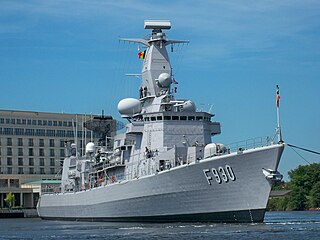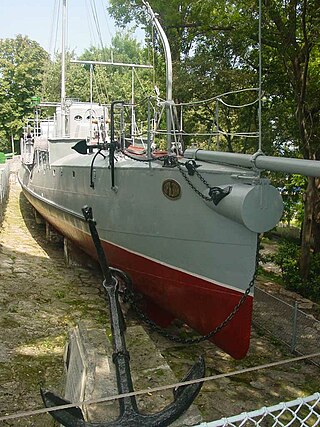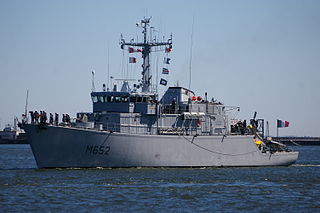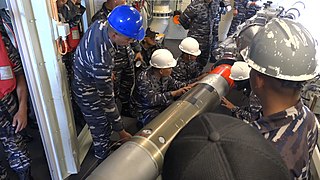
A jack is a flag flown from a short jackstaff at the bow (front) of a vessel, while the ensign is flown on the stern (rear). Jacks on bowsprits or foremasts appeared in the 17th century. A country may have different jacks for different purposes, especially when the naval jack is forbidden to other vessels. The United Kingdom has an official civil jack; the Netherlands has several unofficial ones. In some countries, ships of other government institutions may fly the naval jack, e.g. the ships of the United States Coast Guard and the National Oceanic and Atmospheric Administration in the case of the US jack. Certain organs of the UK's government have their own departmental jacks. Commercial or pleasure craft may fly the flag of an administrative division or municipality at the bow. Merchant ships may fly a house flag. Yachts may fly a club burgee or officer's flag or the owner's private signal at the bow. Practice may be regulated by law, custom, or personal judgment.

Leopold I (F930) is a Karel Doorman-class frigate of the Marine Component of the Belgian Armed Forces. Prior to 29 March 2007, the ship was known as HNLMS Karel Doorman (F827). It is one of the two frigates of this class purchased from the Royal Netherlands Navy on 22 December 2005.

The Karel Doorman-class frigates are a series of eight multi-purpose vessels built for the Royal Netherlands Navy. Its namesake is Karel Doorman, a Dutch naval officer whose ship was struck by a Japanese torpedo in the battle of the Java Sea in 1942, and who, as a result of which, went down with his ship.

Modern French 100 mm naval guns are multipurpose artillery pieces, capable of a high rate of fire. Most modern French warships are or were equipped with one of its variants.

Drazki was a Bulgarian Navy torpedo boat built at the start of the 20th century. A ship of the same class is now a museum ship under her name in Varna.

The Bulgarian Navy is the navy of the Republic of Bulgaria and forms part of the Bulgarian Armed Forces. It has been largely overlooked in the reforms that Bulgaria had to go through in order to comply with NATO standards, mostly because of the great expense involved and the fact that naval assaults are not considered to be a great concern for the country's security. That is why three of the four Romeo-class submarines are now docked and have been out of operation for some time. The last one was decommissioned in November 2011. Only the more modern frigates, corvettes and missile crafts are on active duty.

The Belgian Navy, officially the Belgian Naval Component of the Belgian Armed Forces, is the naval service of Belgium.

A naval ensign is an ensign used by naval ships of various countries to denote their nationality. It can be the same or different from a country's civil ensign or state ensign.

The Wielingen class is a class of four multi-functional frigates built for the Belgian Navy. The ships are named after sandbanks in the North Sea, not far from the Belgian coast, or sea routes. The lead ship is named after the Wielingen sandbank.

The Tripartite class is a class of minehunters developed from an agreement between the navies of Belgium, France and the Netherlands. A total of 35 ships were constructed for the three navies. The class was constructed in the 1980s–1990s in all three countries, using a mix of minehunting, electrical and propulsion systems from the three member nations. In France, where they are known as the Éridan class they are primarily used as minehunters, but have been used for minesweeping and ammunition transport in Belgium and the Netherlands, where the Tripartites are known as the Alkmaar class.

The A244-s is an Italian lightweight, fire-and-forget torpedo employed for anti-submarine warfare. It can be launched from surface vessels or from aircraft, and locates the target by means of an acoustic seeker.

Bellis (M916) is a Tripartite-class minehunter of the Belgian Naval Component, launched on 14 February 1986 at the Mercantile-Belyard shipyard in Rupelmonde and christened by Ellen Goffinet-Rosman, the wife of the then Mayor of Arlon, on 18 September 1986. The patronage of Bellis was accepted by the city of Arlon. It was the second of the Belgian Tripartite-class minehunters.

Crocus (M917) is a Tripartite-class minehunter of the Belgian Naval Component, launched on 3 September 1986 at the Mercantile-Belyard shipyard in Rupelmonde and completed on 5 February 1987. The patronage of Crocus was accepted by the city of Genk. It was the third of the Belgian Tripartite-class minehunters.

Narcis (M923) is a Tripartite-class minehunter of the Belgian Naval Component, launched in 1990, at the Mercantile-Belyard shipyard in Rupelmonde and christened by Mrs. Lafosse-De Backer, the wife of the then Mayor of Mons, on 14 March 1991. The patronage of Narcis was accepted by the city of Mons. It was the ninth of the Belgian Tripartite-class minehunters. The Belgian government chose to deploy the ship as part of its involvement with enforcing the Libyan no-fly zone.

Verni is a Wielingen-class frigate of the Bulgarian Navy. It was originally commissioned as Wielingen in the Belgian Navy.

Gordi is a Wielingen-class frigate of the Bulgarian Navy with number 43. It was originally commissioned as Westdiep in the Belgian Navy.
Linienschiffsleutnant is a German language variant of the naval officer rank ship-of-the-line lieutenant. The rank is used by the Belgian Navy and formerly the Austro-Hungarian Navy.

Louise-Marie (F931) is a Karel Doorman-class frigate of the Marine Component of the Belgian Armed Forces that was commissioned in 2008. It is the second of the two frigates of this class that were purchased from the Royal Netherlands Navy on 22 December 2005. It was originally commissioned in 1991 in the Netherlands, where it served as HNLMS Willem van der Zaan (F829).
HMS Snowdrop was an Azalea-class sloop of the Royal Navy. She served during the First World War. Snowdrop survived the war and was sold for scrap in 1923.

SM UB-45 was a Type UB II submarine or U-boat built for and operated by the German Imperial Navy during World War I. UB-45 operated in the Mediterranean and the Black Seas, and was sunk by a mine in November 1916.

















